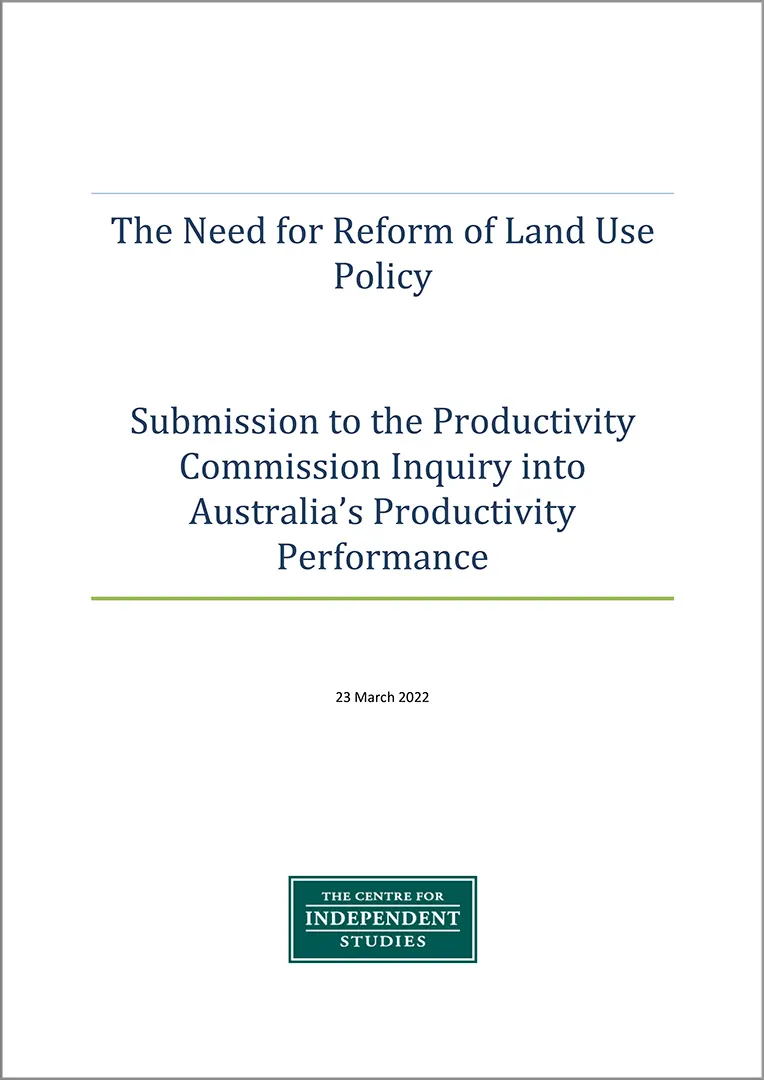
This submission focuses strongly on the housing affordability aspect of Australia’s productivity.
Submission to the Productivity Commission Inquiry into Australia’s Productivity Performance
Shifting the Dial (2017) emphasised the planning system’s ‘red tape’. However, recent research indicates that the more important problem with the planning system is that it restricts the supply of housing, increasing its price. Estimates of this effect in Australian cities are very large. For example, planning restrictions are estimated to raise the cost of the average Sydney apartment by $355,000 or 68%. These estimates are in line with other observations of the Australian housing market and a large body of international research.
In principle, a large effect on prices would be justified if housing density created large negative externalities. However, attempts to quantify the most commonly cited externalities find them to be unimportant or positive. Of special relevance to this inquiry, allowing people to concentrate together in large dense cities has repeatedly been found to boost productivity, technological progress and wages. The welfare costs of these distortions, in terms of equity, deadweight loss and dynamic losses, are all large.
Recommendations
Shifting the Dial recommended streamlining the planning process to reduce administrative costs. The recent research calls for more fundamental reforms. We need to build more housing, especially high density near transport hubs and in the inner suburbs of our big cities. That requires loosening planning restrictions to help boost Australia’s productivity. Planning decisions need to stop over-weighting the objections of nearby residents and start respecting the interests of renters and future generations of home buyers.
Recommendation 1:
As a community, Australia needs to be more accepting of high-density housing. We have been too resistant to change and the resulting lack of urban infill has made housing too expensive. We have placed too much weight on preservation of old structures and the interests of old, wealthy homeowners and not enough weight on the interests of renters and future generations of home buyers.
This change in attitude requires a public education campaign. The Productivity Commission is ideally placed to take a leading role in that. It is not the Commission’s role to call for a change in values. However educating the public about the costs of policy distortions has been a core responsibility since the Tariff Board.
Recommendation 2:
Decisions on land use are primarily the responsibility of state and (to a lesser extent) local governments. They need to stop saying ‘no’ and start saying ‘yes’. Primarily, that requires a change
in attitude, as discussed in Recommendation 1. That said, processes can be made less hostile to development. More specific recommendations, which vary in their applicability from state to state, include:
a) State governments should implement and enforce housing targets for local governments that are ambitious and evidence-based. Targets should prioritise excess demand, as reflected in prices and rents.
b) More ambitious housing targets will often mean raising height limits on apartment buildings, especially near transport hubs.
c) Permitted uses in low density zones should be revised so as to allow more medium-density housing, such as terraces and townhouses, as of right.
d) Planning processes need to place a greater focus on the affordability consequences of supply restrictions. For example, those who oppose extra development should be asked to address
affordability consequences in their submissions and public hearings. Planning bodies that reject applications should specify where the potential residents who would occupy the proposed building should live instead, and why that is a better outcome.
e) Legislation should specify tighter criteria for rejecting development applications. For example, there should be a presumption that proposed development be approved unless
significant harm is demonstrated or that alternative development could provide as much housing at lower cost.
f) To accelerate planning approvals, planning bodies should be given deadlines to respond, with approval being given if the deadline is not met.
g) Heritage controls should preserve architecture that is unusual, not entire neighbourhoods. Preserving history is nice, but turning suburbs into museum exhibits is not worth the cost,
especially when it prices out the previous inhabitants.
Recommendation 3:
As recommended by the recent Federal Parliamentary Inquiry into housing, the Commonwealth government should encourage better decision-making by lower levels of government with financial grants. For example, it could replace some existing unconditional grants and infrastructure spending with grants of say $25,000 per housing completion. The CIS Submission to the Parliamentary Inquiry discusses this issue a greater length.
Recommendation 4:
State and Territory land authorities need to release more land. This is most clearly a problem in the Australian Capital Territory where the Suburban Land Agency abuses its monopoly position for revenue-raising purposes (Stanhope and Ahmed, 2021).
ALSO SEE: Submission to the Inquiry into Housing Affordability and Supply in Australia
SELECTED REFERENCES ON AUSTRALIA’S PRODUCTIVITY IN RELATION TO HOUSING
Ahlfeldt GM and E Pietrostefani (2019), ‘The Economic Effects of Density: A Synthesis’, Journal of Urban Economics, 111, pp 93–107. https://voxeu.org/article/economic-effects-density-synthesis
Baum-Snow, N., Pavan, R. (2013). ‘Inequality and city size.’ Review of Economics and Statistics, 95 (5), 1535-1548 https://direct.mit.edu/rest/article-abstract/95/5/1535/58138/Inequality-and-CitySize
Been, Vicky (2018) ‘City NIMBYs’ Journal of Land Use & Environmental Law https://furmancenter.org/research/publication/city-nimbys










